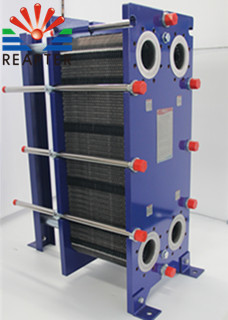The temperature difference design of the heat exchanger
What are the methods for heat exchanger temperature difference design? The heat exchanger manufacturer introduces us to this knowledge:

1. Calculate the necessary heat exchange area. Go back to calculate the heat transfer area and check the pressure drop. The allowable pressure drop is often a limiting factor in the design of the heat exchanger. High-efficiency design always requires sufficient allowable pressure drop. If the relationship between heat transfer load, flow rate and allowable pressure drop cannot be coordinated no matter how the process layout is changed, only inefficient design schemes can be made.
2. Select the heat exchanger process and the number of channels, initially select the cold and hot fluid process and the number of channels, and calculate the flow rate from this.
3. Estimate the heat exchange area, and calculate the approximate heat exchange area based on the heat exchange amount.
4. Choose the appropriate plate model, and select the appropriate plate model according to the heat exchange and flow rate. The choice of plate model depends on the specific working conditions. When the flow rate is large and the pressure drop is low, the plate type with lower resistance should be selected; otherwise, the plate type with a slightly larger resistance coefficient can be used.
5. Finding the average temperature difference of the heat exchanger is very important for the design of the heat exchanger temperature difference.
6.To find the convective heat transfer coefficient and total heat transfer coefficient, first obtain the convective heat transfer coefficients of cold and hot fluids respectively to calculate the total heat transfer coefficient.
7. Calculate the unknown temperature or flow rate, calculate the unknown temperature or flow rate through the heat balance equation, and also calculate the heat load Q.
The heat exchanger temperature difference design is introduced here. If the design is not always satisfactory, you can consider changing the plate type of the heat exchanger.
Related information
- What should i pay attention to when choosing a wide gap plate heat exchanger?
- What are the advantages of industrial plate heat exchangers in applications
- Why is GEA plate heat exchanger so popular in the food industry?
- Industrial plate heat exchanger customization has the trick, many people have ignored these points
- What are the flow modes of the medium in the plate and shell heat exchanger?
- During the installation process of the plate heat exchanger, the choice of the interface form is also very important.
Relevant article
- Heat station supporting plate heat exchanger installation is a technical work, these points should be noted
- Sulfuric acid and other corrosive media for industrial plate heat exchanger requirements are what
- Simple and effective chemical cleaning method of coal chemical plate heat exchanger, can effectively improve efficiency
- A high-quality petrochemical plate heat exchanger in the production of what to consider
- These causes of chemical plate heat exchanger gasket aging you may not know
- Chemical plant plate heat exchanger, sulfuric acid cooling needs attention
- High-end plate heat exchanger customization, specifically for your special working conditions
- The working principle of gasket type industrial plate heat exchanger and the scenarios of its use are worth knowing in depth
- Still worrying about the wholesale price of industrial plate heat exchangers? An article to make you no longer tangled
- The original lubricant in the chemical plate heat exchanger plays so many roles!
Latest information
- Heat station supporting plate heat exchanger installation is a technical work, these points should be noted
- Sulfuric acid and other corrosive media for industrial plate heat exchanger requirements are what
- Simple and effective chemical cleaning method of coal chemical plate heat exchanger, can effectively improve efficiency
- A high-quality petrochemical plate heat exchanger in the production of what to consider
- These causes of chemical plate heat exchanger gasket aging you may not know
- Chemical plant plate heat exchanger, sulfuric acid cooling needs attention
- High-end plate heat exchanger customization, specifically for your special working conditions
- The working principle of gasket type industrial plate heat exchanger and the scenarios of its use are worth knowing in depth
- Still worrying about the wholesale price of industrial plate heat exchangers? An article to make you no longer tangled
- The original lubricant in the chemical plate heat exchanger plays so many roles!








